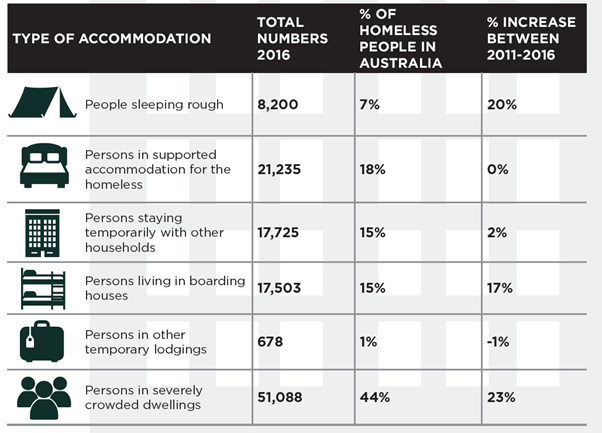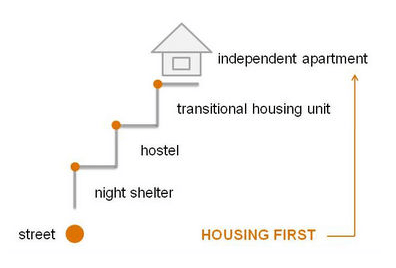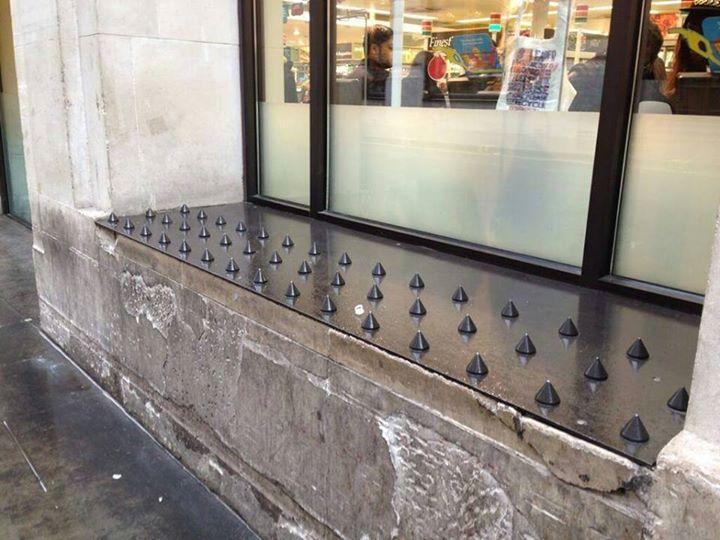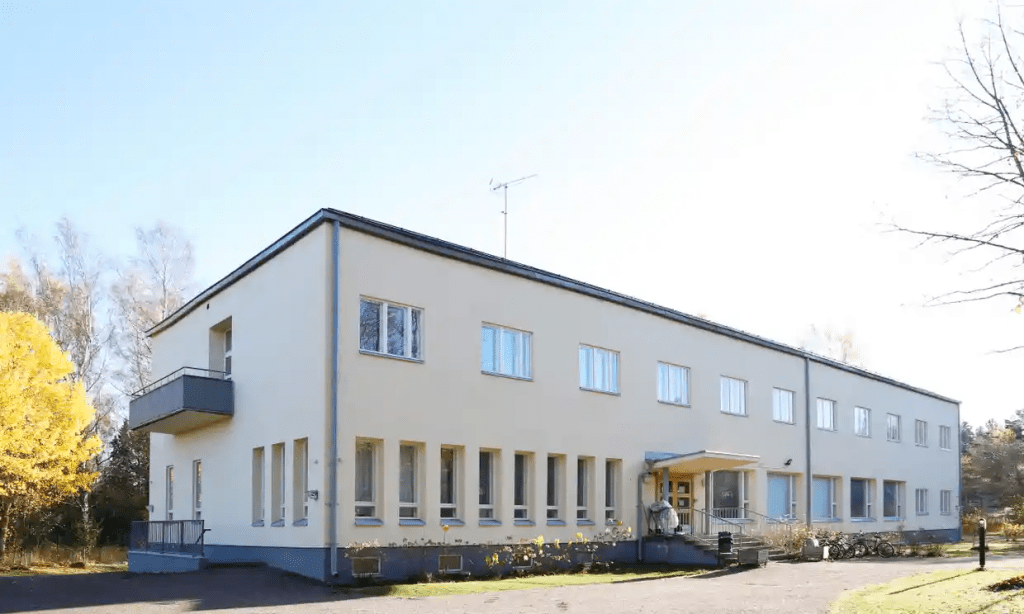Homelessness deprives people of safe and secure housing, a basic human right. Yet for the 1 in 200 Australians who lack a home (as of 2016), a place to call home is out of reach. However, only a few live on the streets. Many survive in homeless shelters or move between friends’ and relatives’ homes. On top of this, more and more are squeezed into overcrowded dwellings, which often lack privacy.

Lacking a home means more than having no shelter. Many become disconnected from their communities, and lose the ability to control their own environment. Homelessness also tends to worsen health outcomes, as people often struggle for food, water, and a place to sleep. Combined with difficulties in reaching and affording health care, issues often stay untreated until it’s too late. This lack of treatment tends to strain emergency health systems. As a result, someone without a stable home, on average, will die 17 years earlier than if they had somewhere to live.
Why is Homelessness Such a Major Issue?
Despite governments and charities working to solve homelessness, more people than ever have no homes. Estimates state that over 2.5 million Australians have been homeless at least once in their lives. With homelessness surging by 14% between 2011 and 2016, it is becoming a larger part of our society. People from all walks of life have experienced homelessness, from our elders, to the young children who make up over a tenth of Australia’s unhomed population.
Current Homelessness Solutions
Many existing solutions rely on people solving their problems themselves before they gain a home. Known as a staircase model, this assumes that people can do so. In reality, this rarely happens as lacking a stable home often makes it harder for people to solve issues.

Hostile architecture: From sloped benches to spikes on sheltered floors, many cities design spaces to discourage people from sleeping on the streets. Rather than shrinking homeless numbers, this often pushes them to other spaces. Making places uncomfortable affects everyone, not just those who sleep rough. As a result, they tend to pull our communities apart by making people less likely to interact in these spaces.
Criminalising homeless behaviours: Hardly anyone chooses to be homeless. Despite this, many treat it as a moral failing or a lifestyle choice. As a result, many who sleep on the streets are charged with crimes and discriminated against. These make it harder for people to escape from homelessness.

Giving people shelter: Turning unused structures into accommodation, providing spaces for tent cities, and building homes from containers are a few ways organisations have tried to help those without homes. However, making these places livable is often difficult and expensive. Shipping containers, for instance, often have traces of dangerous chemicals inside.
Many of these are also temporary, meant for people to move on once they’ve rebuilt their lives. Without support, many end up stuck in these shelters permanently, which can lead to overcrowding. Overcrowded shelters are less able to help people.
Assumptions about homelessness mean that solutions often fail to solve the problem. In reality, providing shelters or forcing people away from the streets cannot solve homelessness. There are many reasons why someone may not have a place to live, and these must be fixed before change can happen.
How Does Homelessness Happen?
Outside factors often pull people into homelessness. For example, a survey of Australians who had been homeless in the past decade found that limited housing markets and financial problems were the biggest reasons why people lacked stable homes. Debts, job losses, or other changes in circumstances often cause issues. These include broken families, substance abuse and mental health issues. By dragging individuals and families from their homes, they can become ignored by society.

Photo by Camila Quintero Franco on Unsplash
However, health issues can also make it harder to find and keep housing. For instance, a study found that 45% of homeless people in the US struggle with mental health issues. One reason for this is that being unable to control one’s circumstances can harm mental health. Without being able to control their environment, it is harder to recover. As a result, many turn to unhealthy ways of coping, such as drug and alcohol abuse.
With nowhere to turn to and no one to help, is it any wonder that people have nowhere to live? Personal factors and outside circumstances combine to trap people in homelessness. This means homelessness affects everyone differently. With this in mind, a blanket solution won’t solve the problem. Instead, cities have found better solutions to deal with homelessness. The secret is to deal with problems locally.
How Can We Make Better Homelessness Solutions?
Solutions should cater to individuals’ needs. One way to help people rebuild their lives is to provide permanent housing.
Helsinki, Finland, previously housed people in shelters. However, since 2008, they have built permanent, comfortable homes from flats and old homeless shelters. These are offered, with no conditions, to those without housing.

At the same time, they can choose supports based on their needs, from health care and financial help, to housing advisors. This can ensure they gain the support they need, instead of what others think they need. Since it launched, this has reduced the number of homeless people in Finland by 35%-the only country in the EU where homelessness is falling.
While it did cost €250m to build new homes and hire support workers, this approach has saved up to €15,000 a year for every person given a home. However, offering homes by themselves is not enough. Their success came from two factors: having enough housing for everyone, and providing support to those in danger of losing their homes. It’s also important to engage and inform local communities near these housing blocks, as locals may distrust the homeless individuals moving into their neighbourhood.
Integrating Communities Through Supportive Housing
Solving the issues needs more than housing and support. By integrating people into communities, they can gain the support they need to recover. Trieste, Italy, aims to help those with mental health issues through communal housing. Instead of treating them as criminals, these houses provide support for their issues. People in the community are encouraged to help them take part in community activities, and even give them jobs. This support helps them recover, and can connect them back to society.

Photo by Victória Kubiaki on Unsplash
Similar to mental health issues, many without stable homes need flexibility. Inflexible work practices often make it harder for unhomed individuals to keep their jobs. Hence, flexible work can help people take control of their lives.
Using Data To Solve Local Issues
Homelessness affects communities in different ways. Therefore, knowing what contributes to homelessness in local areas can make it easier to solve them. Built For Zero, a US-based program aims to use data to create solutions that save people from homelessness. They seek to know the obstacles that push each person away from a stable home, and give organisations and charities a way to solve them together.
The THRIVE Project has a framework that lets governments and charities track their impacts, and understand how their efforts can help the most people. Together, we can ensure everyone has the chance to not just survive, but thrive!
If you want to plant the seeds of change, click this link to find out more about our THRIVE platform.

















